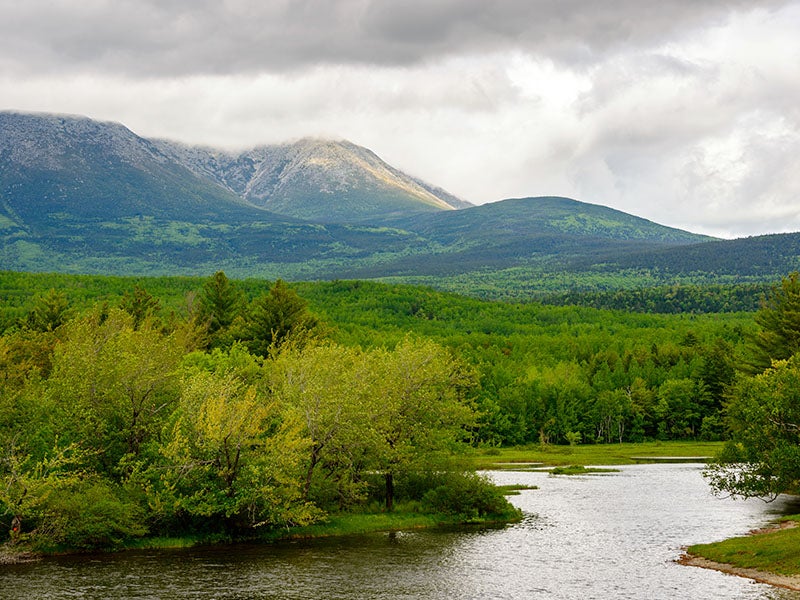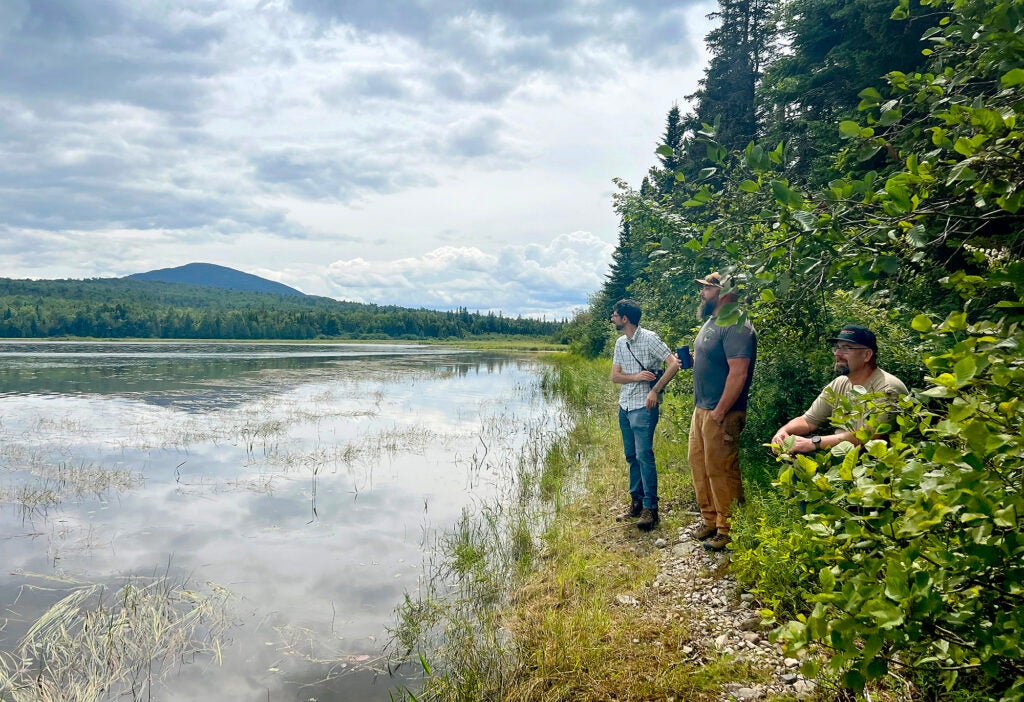Mainers Send a Message to Mining Industry: “Don’t Come for Katahdin”
State regulator rejects a mining proposal from an inexperienced company that would have threatened an area of pristine water important to local tribes.

This page was published a year ago. Find the latest on Earthjustice’s work.
When hikers come from near and far to climb Mount Katahdin, Maine’s highest peak, it isn’t always for the view. Rising 4,000 feet above a sea of forest, reaching Katahdin’s summit is considered a backpacking milestone.
For the Wabanaki Nations of Maine, Mount Katahdin is much more than a hiker’s bragging rights. Chuck Loring Jr., a member of the Penobscot Nation (which is a part of the Wabanaki Confederacy), knew the moment he’d entered a sacred place.
“I tried to hike it with my buddy,” says Loring, “but something didn’t want me to keep going. My buddy went ahead, but I stopped to take it all in.”
Surrounded by Katahdin’s beauty, Loring took the moment to call his grandmother and absorb the green summer day. He eventually heeded his instinct and turned back. “It always bothered me that I never made it,” reflects Loring. Yet some time later, he attended a conference the tribe was hosting, where a respected Penobscot councilor explained how Katahdin is a spiritual anchor for the Penobscot — where one should enter with a whole heart, or not at all.
Once Loring heard about his Tribe’s roots in Mount Katahdin, he realized, “that’s totally why I didn’t want to continue.”
The Katahdin region is the ancestral home of the Wabanaki Tribes. The Penobscot River, with its five major watersheds, were once important canoe highways among the Tribes. Today, Tribal members make a 100-mile pilgrimage from Indian Island to Mount Katahdin, by foot or canoe. The Penobscot and Maliseet use the area to practice important cultural traditions, including hunting, fishing, gathering medicines, and ceremonies.
Katahdin is also a huge economic driver for the local outdoor recreation industry, drawing tens of thousands of visitors and nearly $3 million per year.
So, when an inexperienced mining company came to town with a proposal to build a mine in the Katahdin region that would potentially decimate this pristine river system, the Tribes, local conservation groups, and hundreds of Mainers didn’t hesitate to fight back.

A coalition of opponents to Wolfden’s proposed mine in Maine’s Katahdin region demonstrate before the Maine Land Use Planning Commission’s vote on Feb. 14. (Courtesy of Community Water Justice)
The mining company, Wolfden, was problematic from the get-go.
The company had never operated a mine before. It had never even produced a profitable venture before. Yet, Wolfden claimed it could do a level of environmental mitigation that no mining company has ever achieved.
The company didn’t bother to hide its disdain for Tribal rights: in an investor meeting, Wolfden’s CEO made the offensive and inaccurate claim that the “lack of Indigenous rights” in the area made it ideal to develop.
Wolfden’s first mining proposal, in 2020, was riddled with errors. The Maine Land Use Planning Commission (LUPC), which oversees planning and zoning at the proposed site, told Wolfden that it intended to reject the project outright. Wolfden withdrew its proposal, but the Natural Resources Council of Maine (NRCM), Conservation Law Foundation, Maine Audubon, the Houlton Band of Maliseet Indians, and the Penobscot Nation stayed alert for its inevitable resurrection.
Dan Kusnierz, who manages the Penobscot’s Water Resources Program, knew how destructive Wolfden’s mine would be to the Katahdin region. Acid mine drainage — a potential contaminant from mining operations — can be lethal to fish and other aquatic life, and wildlife and can continue escaping into the groundwater and ultimately surface water even after a mine closes.
“I’ve visited other mines in Indian Country in the United States,” says Kusnierz. “I’ve seen the devastation that it’s created. The thought of that taking place here is really bad.”
The mine threatened to undo decades of painstaking work that the Penobscot Nation had done to restore the polluted river and bring back the endangered Atlantic salmon. In 1999, the Penobscot partnered with a trust comprised of private advocacy groups and conservation organizations, who worked with state and federal agencies to bring back the river. Together, they removed two dams and improved the water quality — restoring access for endangered and migratory fish to 2,000 miles of the Penobscot river.
The results are staggering. As of last year, over 5 million fish, including alewives and herring, were counted in the watersheds. The coating of algae and industrial products that once choked the surface of the water from past industrial uses has disappeared. In time, the Penobscot hope to eat the fish from their namesake river without fear of contamination.
This, among so many other things, was what the Penobscot stood to lose.
“It’s been phenomenal to see the river come back to life,” says Kusnierz. “To see something like Wolfden’s mine smack dab in the middle of all that was very frightening. It’s a wild and special place.”

Earthjustice attorney Aaron Bloom, Penobscot Nation member Chuck Loring Jr., and Dan Kusnierz, water resources program manager for the Penobscot Nation, left to right, visit the Katahdin region in Maine where Wolfden proposed developing a metal mine. (Laura Berglan / Earthjustice)
As the Tribe feared, Wolfden returned with a new mining proposal in January 2023. The conservation groups and Wabanaki Tribes who’d been wary since the initial rejected proposal decided to act — which is where Earthjustice attorneys came in from three different angles. Aaron Bloom from the Biodiversity Defense Program, Marissa Lieberman-Klein from the Northeast Regional office, and Laura Berglan in the Tribal Partnerships Program came together to challenge Wolfden’s proposal on behalf of the Penobscot Nation, the Houlton Band of Maliseet Indians, Maine Audubon, and the Natural Resources Council of Maine. The Conservation Law Foundation also joined Earthjustice and its clients in challenging the proposal.
Bloom and his team found that Wolfden’s new proposal was just as flawed as before.
“We kept pressing them to give us an example of a mine that had met the water quality standards they were promising,” says Bloom. “Wolfden’s mine would be in an area with pristine water, federally designated as critical habitat for endangered salmon. It’s considered some of the best habitat in all of Maine. This inexperienced, underfunded company had not proven that it could prevent acid mine drainage. Why would you buy those promises?”
Local Tribes and outdoor enthusiasts did not — loudly.
Hundreds of Mainers submitted written comments opposing the mine over a public comment period. At a three-day technical hearing, Kusnierz and others gave testimony outlining the importance of keeping the Katahdin region’s pristine waters free of contamination, and the lengths that the Penobscot and others have gone to maintain its ecological balance.
The LUPC heard their vehement opposition: in February, the Commission firmly rejected Wolfden’s proposal.
The ruling sends a message to other mining companies and protects a place that is intimately sacred to the Penobscot. For Chuck Loring, the river is a living legacy for future generations — a lesson he took to heart after the birth of his daughter. “We named her River, because they’re strong, powerful, and unique.
The Biodiversity Defense Program fights to reshape our relationship to lands, water, and wildlife everywhere by confronting the major drivers of the decline in nature, including habitat destruction and over-exploitation of wildlife.
Established in 2008, Earthjustice’s Northeast Office, located in New York City, is at the forefront of issues at the intersection of energy, environmental health, and social justice.
We fight to ensure our tribal and Indigenous clients’ natural and cultural resources are protected for future generations.